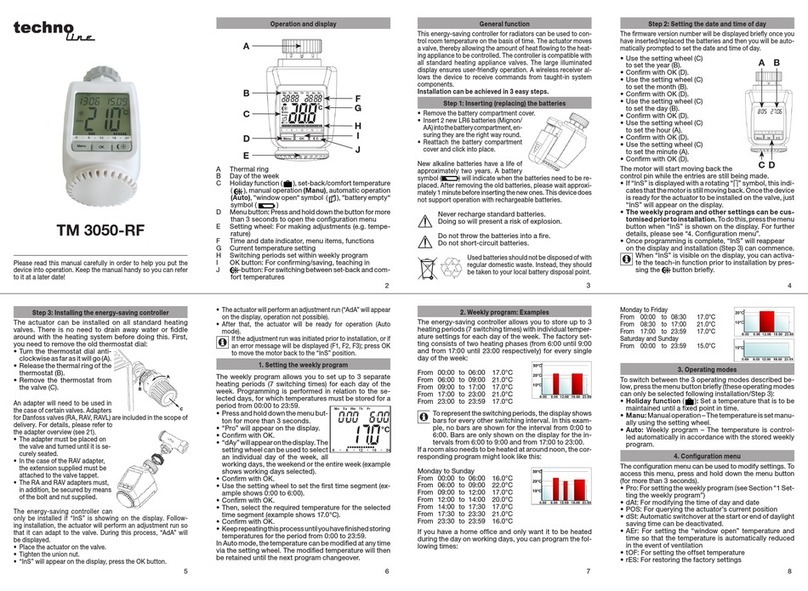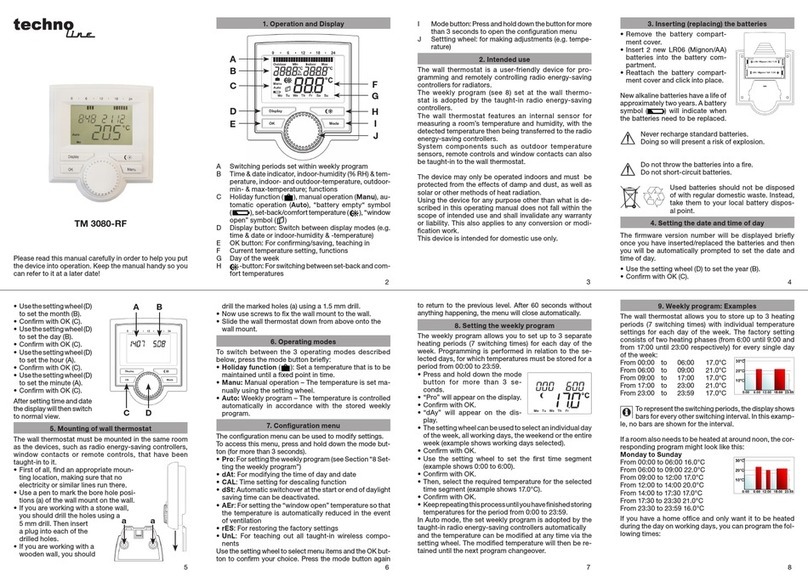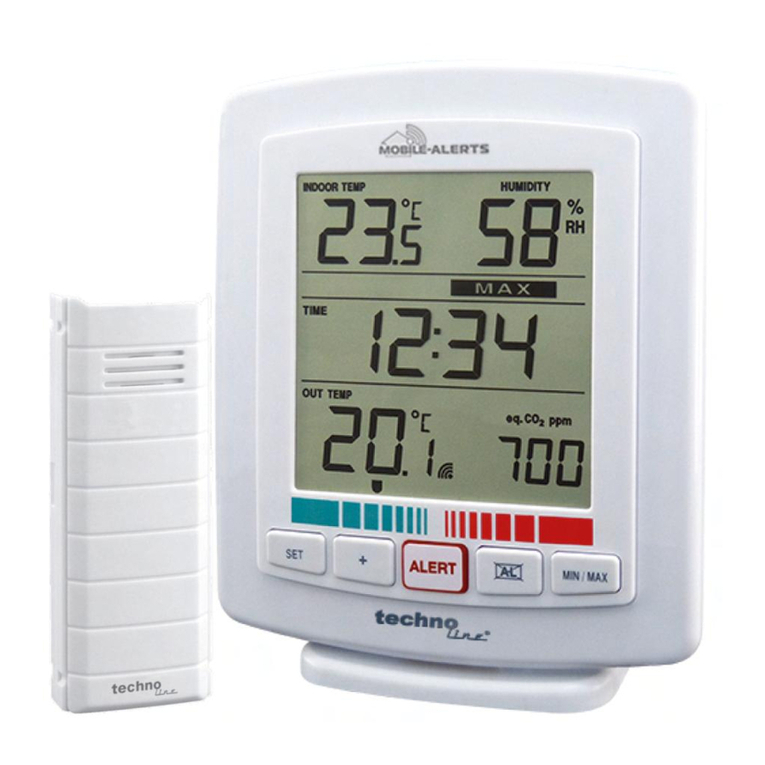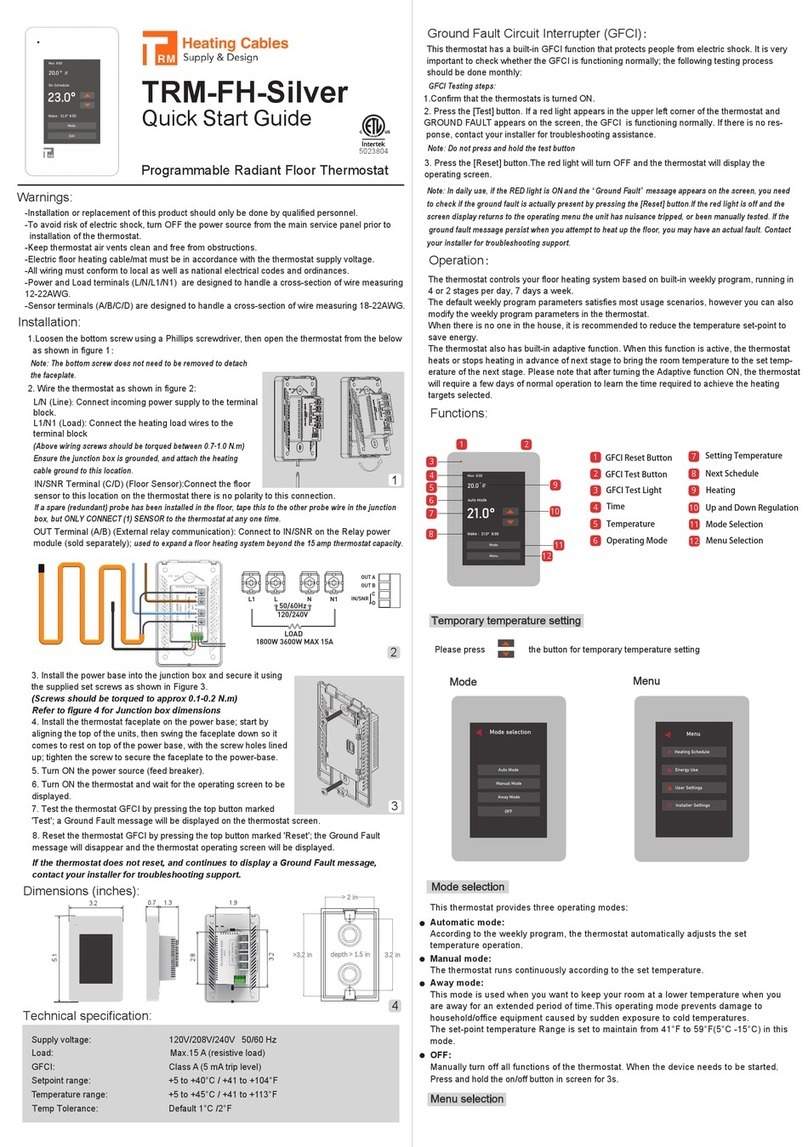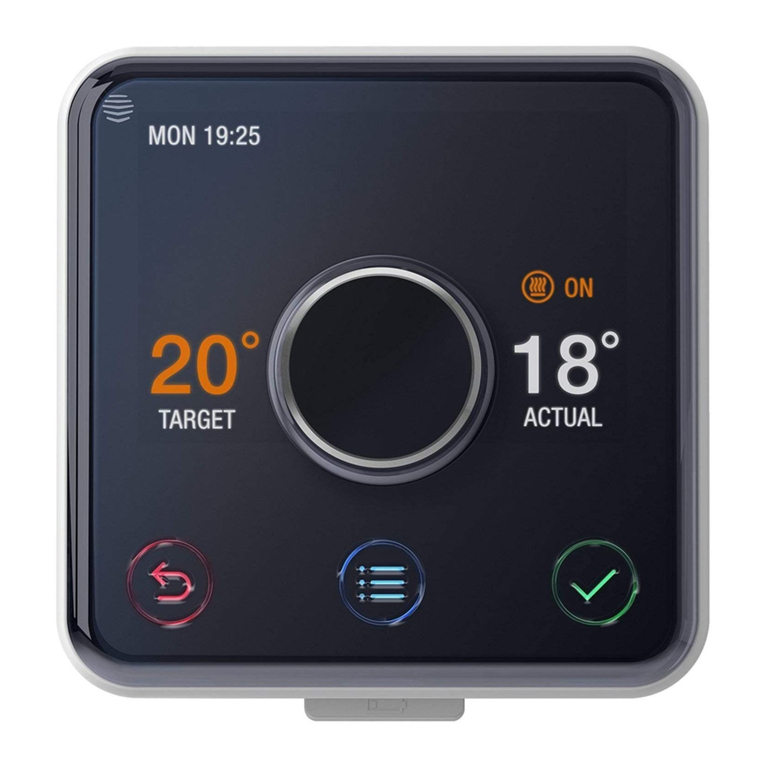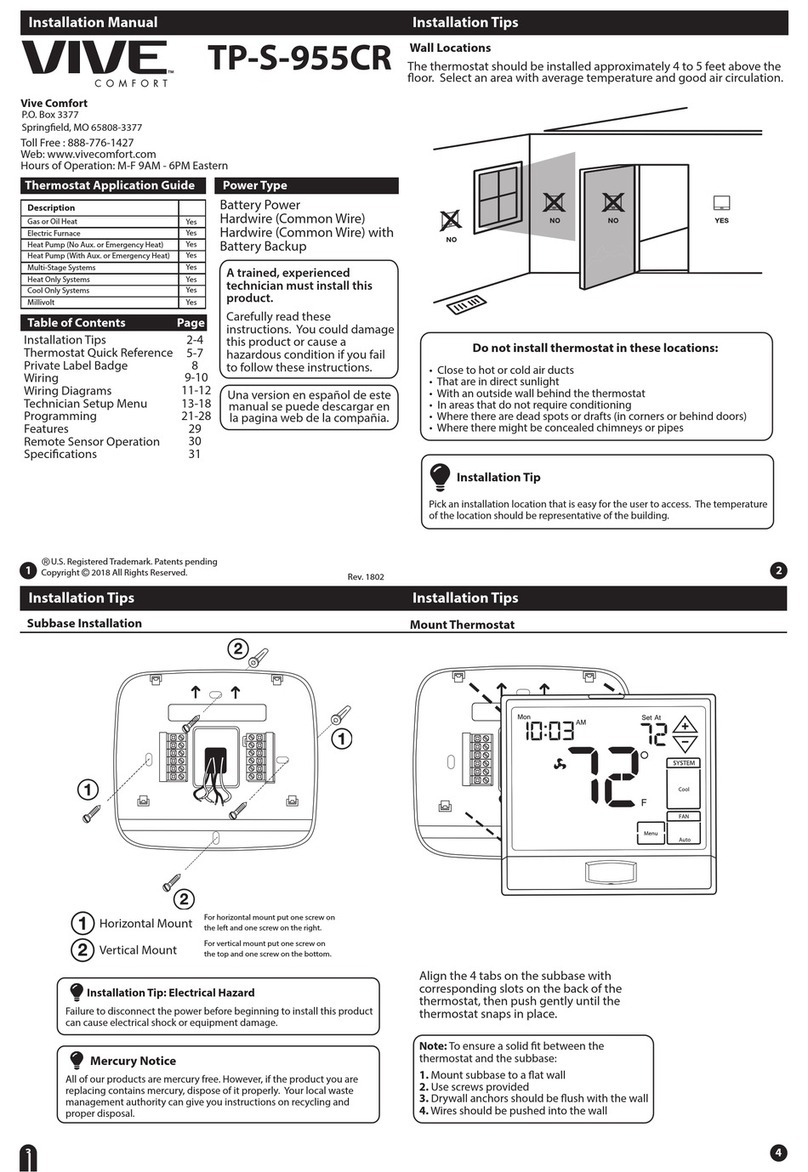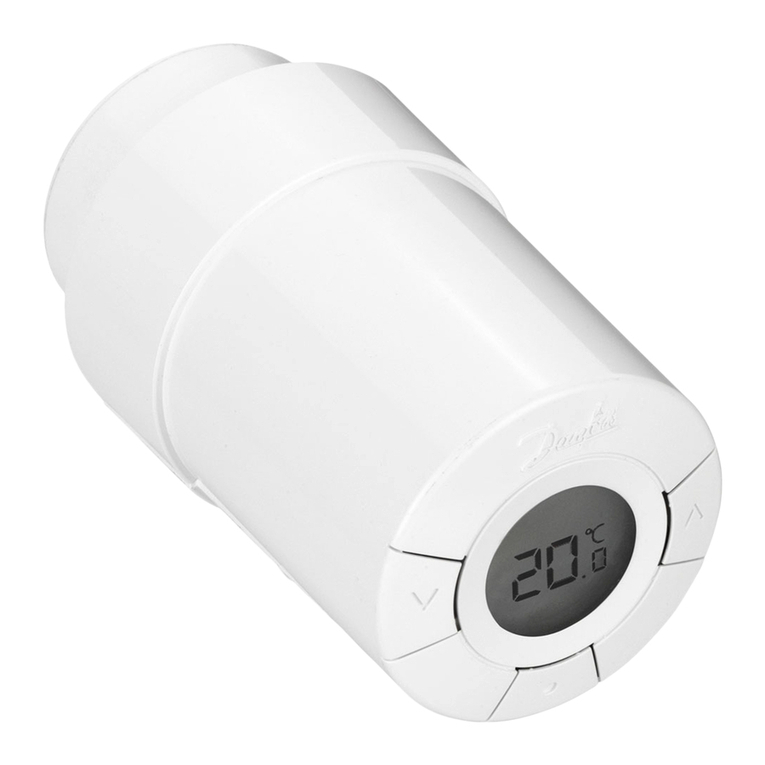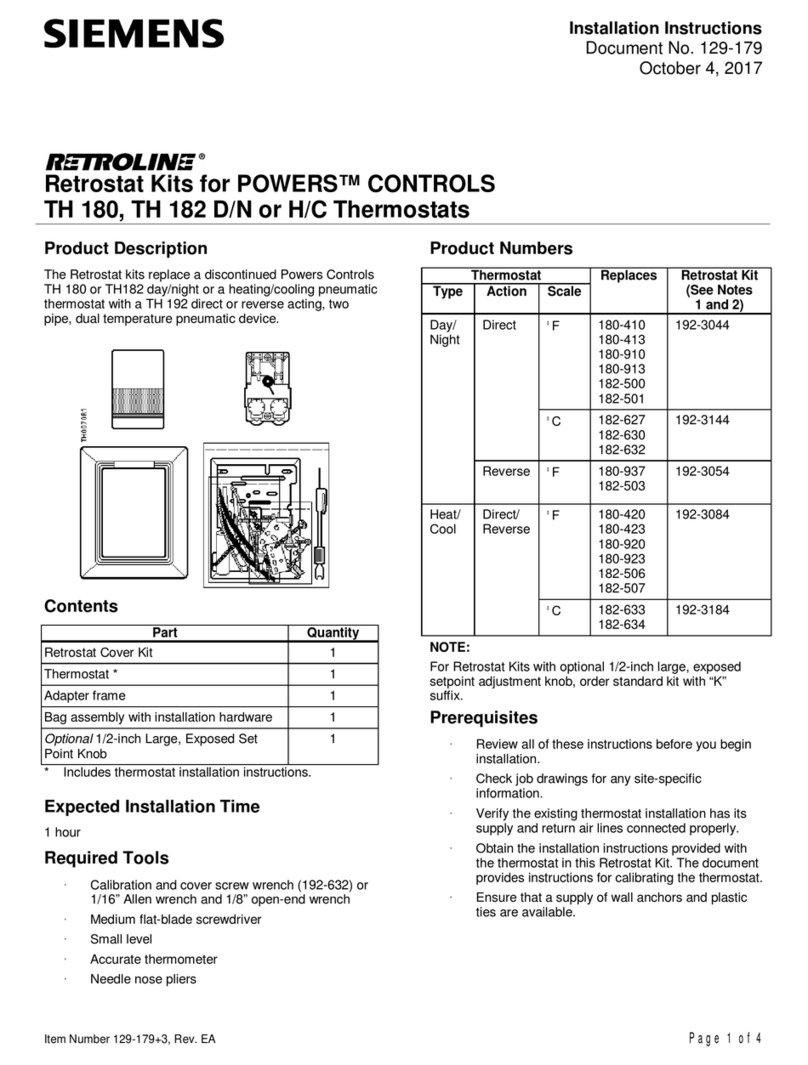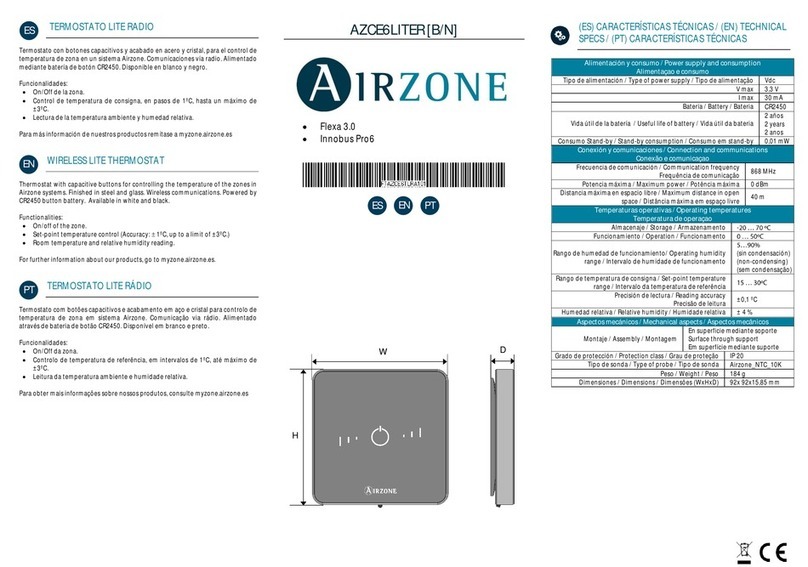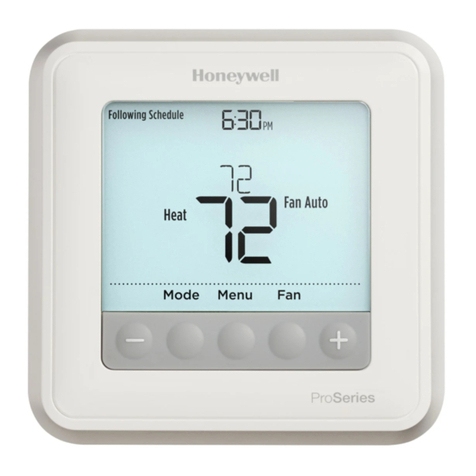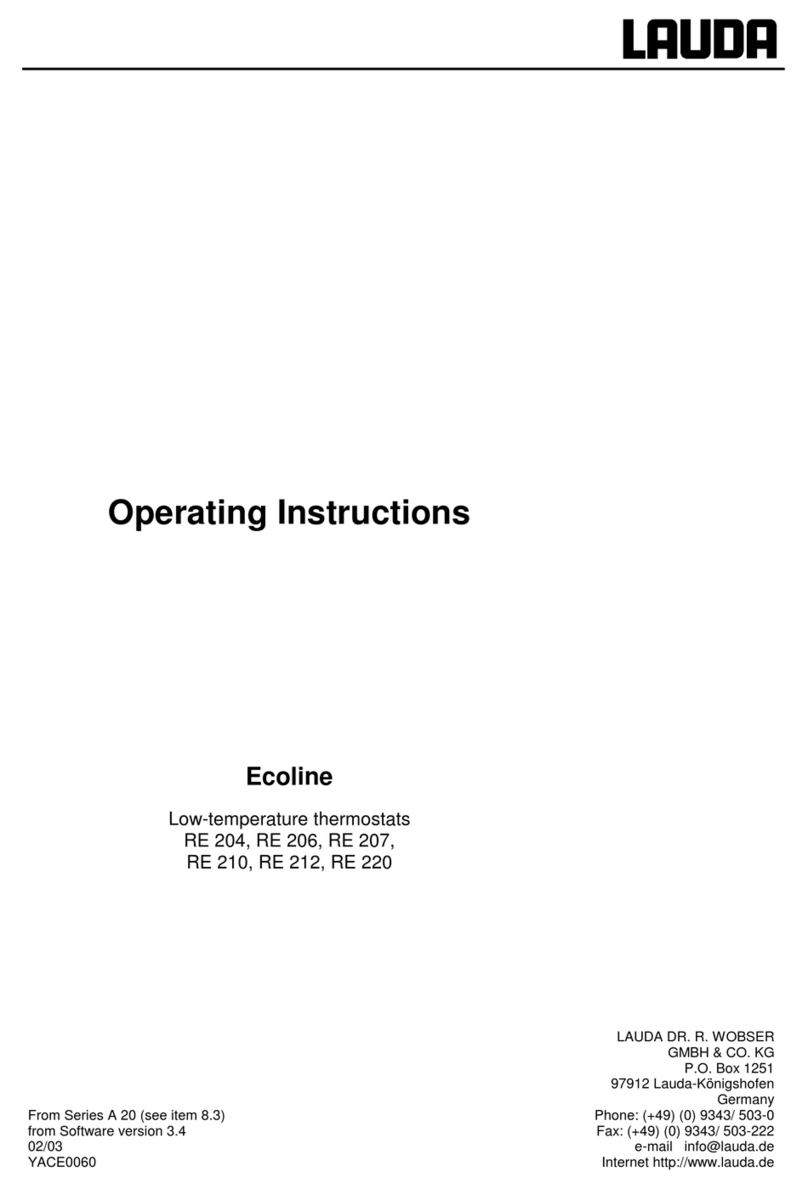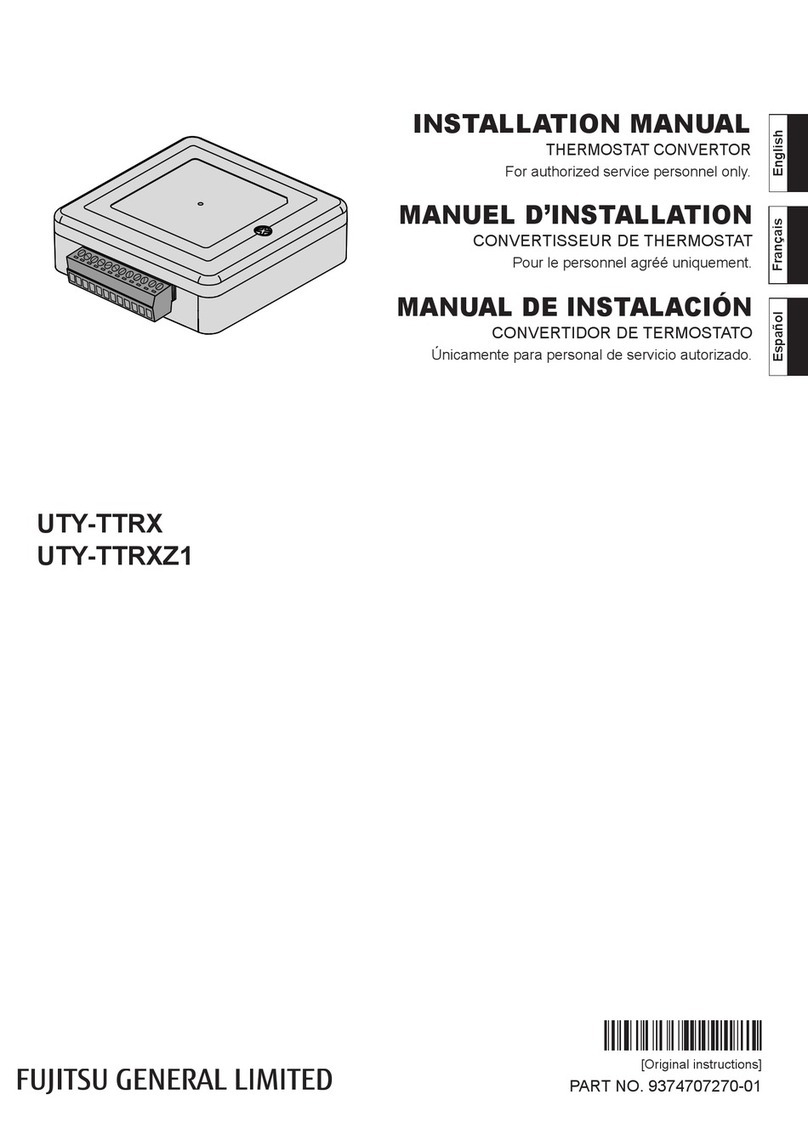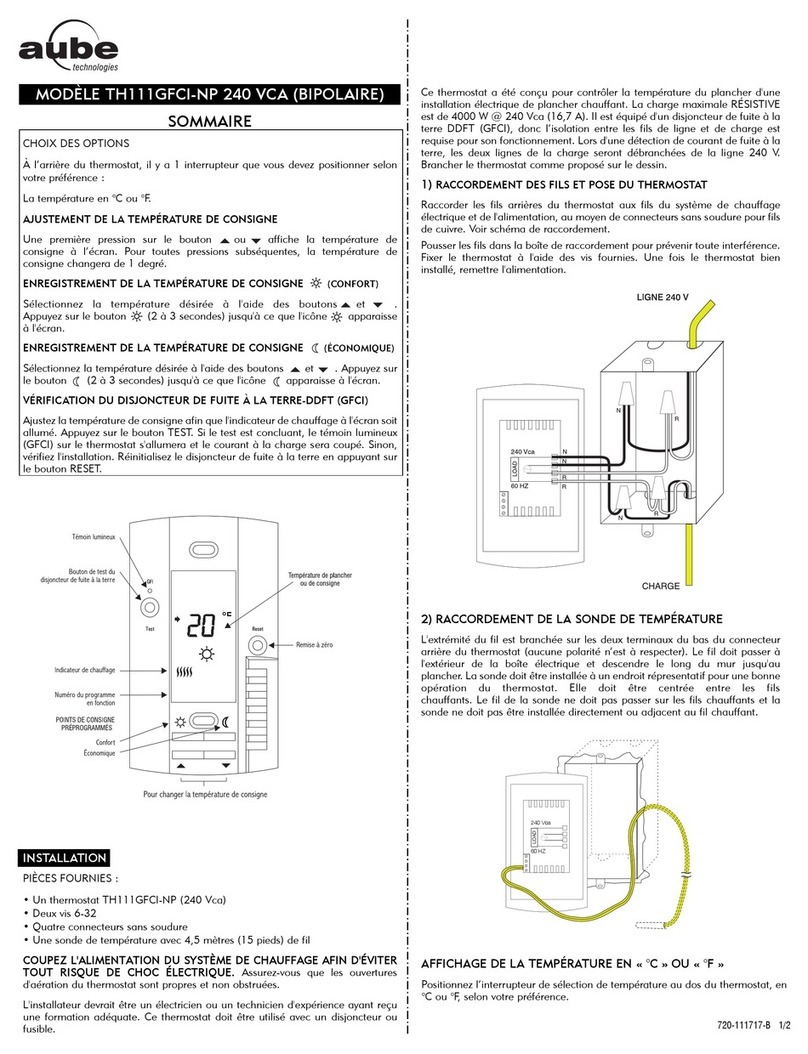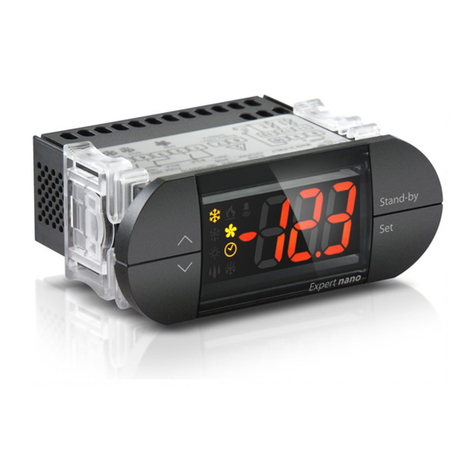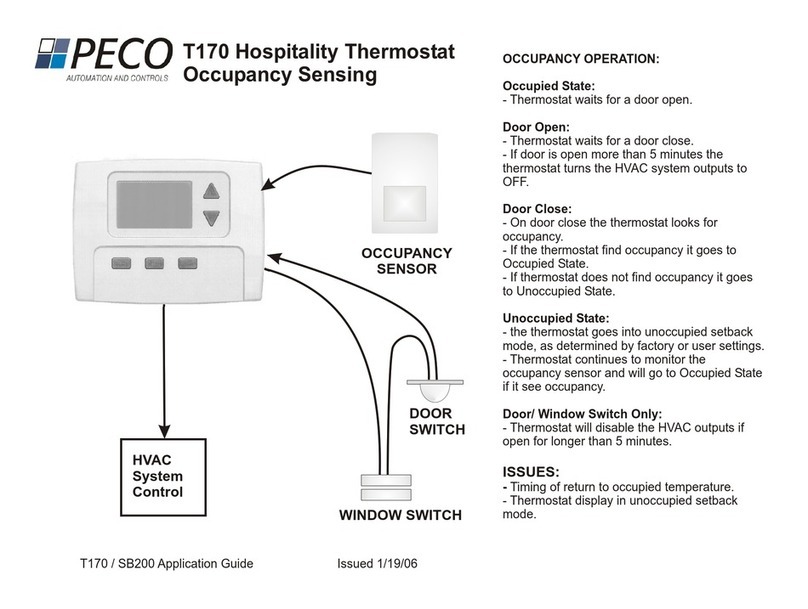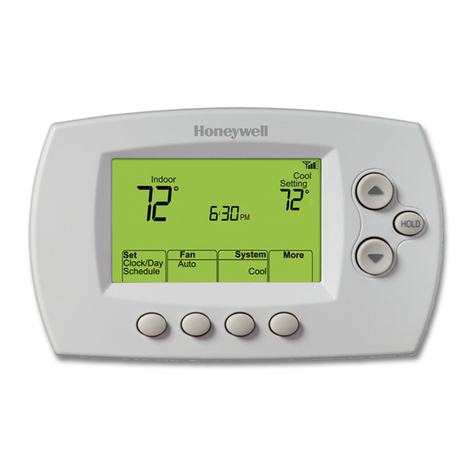Technoline TM 3070-RF User manual

G
F
H
D
E J
C
B
A
I
A
CB D
Operation and display General function
This energy-saving controller for radiators can be used to
co nt ro l room te mp er at ur e on the basis of t im e. T he actuato r mo ves
a valve, thereby allowing the amount of heat flowing to the heating
appliance to be controlled. The controller is compatible with all
standard heating appli anc e valve s. A wi reless r eceiver allow s the
device to receive commands from taught-in system components.
Installation can be achieved in 3 easy steps.
Step 1: Inserting (replacing) the batteries
Remove the battery compartment•
cover.
Insert 2 newLR6 batteries (Mignon/AA)•
intothe battery compartment,ensuring
they are the right way round.
Reattach the battery compartment•
cover and click into place.
New alkaline batteries have a life of approximately two years. A
battery symbol ( ) will indicate when the batteries need to
be replaced. After removing the old batteries, please wait ap-
proximately 1 minute before inserting the new ones. This device
does not support operation with rechargeable batteries.
Never recharge standard batteries.
Doing so will present a risk of explosion.
Do not throw the batteries into a fire.
Do not short-circuit batteries.
Used batte rie s should n ot be d isp ose d of wi th
regular domestic waste. Instead, they should
be taken to your local battery disposal point.
Step 2: Setting the date and time of day
The firmware version number will be displayed briefly once you
have inserted/replaced the batteries and then you will be auto-
matically prompted to set the date and time of day.
Use the arrow buttons (B/D) to set•
the year (A).
Confirm with OK (C).•
Use the arrow buttons (B/D) to set•
the month (A).
Confirm with OK (C).•
Use the arrow buttons (B/D) to set•
the day (A).
Confirm with OK (C).•
Use the arrow buttons (B/D) to set•
the hour (A).
Confirm with OK (C).•
Use the arrow buttons (B/D) to set•
the minute (A).
Confirm with OK (C).•
The motor will start moving back the
control pin while the entries are still being made.
If “INS” is displayed with a rotating “•
∏
” symbol, this indi-
cates that the motor is still moving back. Once the device is
ready for the actuator to be installed on the valve, just “INS”
will appear on the display.
The weekly program and other settings can be custom-•
ised prior to installation. To do this, press the menu button
when “INS” is shown on the display. For further details, please
see “4. Configuration menu”.
Once programming is complete, “INS” will reappear on the•
display and installation (Step 3) can commence.
When “INS” is visible on the display, you can activate the
teach-in function prior to installation by pressing the
button briefly.
Step 3: Installing the energy-saving controller
The actuator can be installed on all standard heating valves.
There is no need to drain away water or fiddle around with the
heating system before doing this. First, you need to remove the
old thermostat dial:
Turn the thermostat dial anti-•
clockwise as far as it will go (A).
Release the thermal ring of the•
thermostat (B).
Remove the thermostat from the•
valve (C).
An adapter will need to be used in
the case of certain valves. Adapters
for Danfoss valves (RA, RAV, RAVL) are included in the scope of
delivery. For details, please refer to
the adapter overview (see 21).
The adapter must be placed on•
the valve and turned until it is se-
curely seated.
In the case of the RAV adapter,•
the extension supplied must be
attached to the valve tappet.
The RA and RAV adapters must,•
in addition, be secured by means
of the bolt and nut supplied.
The energy-saving controller can
only be installed if “INS” is showing on the display. Follow-
ing installation, the actuator will perform an adjustment run so
that it can adapt to the valve. During this process, “ADA” will
be displayed.
Place the actuator on the valve.•
Tighten the union nut.•
“INS” will appear on the display, press the OK button.•
The actuator will perform an adjustment run (“ADA” will appear•
on the display, operation not possible).
After that, the actuator will be ready for operation (Auto•
mode).
If the adjustment run was initiated prior to installation, or if
an error message will be displayed (F1, F2, F3); press OK
to move the motor back to the “INS” position.
1. Setting the weekly program
The weekly program allows two separate heating phases (four
switching times) to be set for each day of the week. The pro-
grammed settings only apply to the selected days. Outside these
times the actuator reduces the temperature to the spe cified set-
back temperature (see 10).
Press and hold down the Menu button for longer than•
3 seconds.
“PRO” appears on the display.•
Confirm by pressing the OK button.•
“DAY” appears on the display. You can use the arrow•
buttons to select a single day of the week, all weekdays,
the weekend, or the entire week (weekdays has been se-
lected in the example).
Confirm your selection by pressing the OK button.•
The first heating phase switching•
time is displayed (6:00); you can
change this time with the arrow
buttons. Heating intervals are also
shown by means of bars.
Confirm by pressing the OK button.•
You then need to set the tempe-•
rature that the room should be at
from 6:00 onwards (21.0°C in the
example).
Confirm your selection by pressing the OK button.•
The end time for the first heating•
interval is displayed (9:00 in the
example); you can change this time
with the arrow buttons.
Confirm by pressing the OK button.•
Repeat this procedure for the second heating interval.•
In auto mode (weekly program), the temperature can be
changed at any time using the arrow buttons. The modi-
fied temperature will then remain the same until the next
point at which the program changes.
2. Weekly program: Examples
The energy-saving controller allows you to store up to 2 heating
periods (4 switching times) with individual temperature settings
for each day of the week. The factory setting consists of two
heating phases (from 6:00 until 9:00 and from 17:00 until 23:00
respectively) for every single day of the week:
From 00:00 to 06:00 17.0°C
From 06:00 to 09:00 21.0°C
From 09:00 to 17:00 17.0°C
From 17:00 to 23:00 21.0°C
From 23:00 to 23:59 17.0°C
The display shows bars for every heating interval. In this
example, no bars are shown for the interval from 0:00 to
6:00. Bars are only shown on the display for the intervals
from 6:00 to 9:00 and from 17:00 to 23:00.
If a room also needs to be heated at around noon, the corre-
sponding program might look like this:
Monday to Sunday
From 00:00 to 06:00 17.0°C
From 06:00 to 14:00 22.0°C
From 14:00 to 17:30 17.0°C
From 17:30 to 23:30 21.0°C
From 23:30 to 23:59 17.0°C
If you have a home of fic e and o nly want it to b e hea ted during the
day on working days, you can program the following times:
Monday to Friday
From 00:00 to 08:30 17.0°C
From 08:30 to 17:00 21.0°C
From 17:00 to 23:59 17.0°C
Saturday and Sunday
From 00:00 to 23:59 17.0°C
3. Operating modes
To switch between the 3 operating modes described below,
press the menu button briefly (these operating modes can only
be selected following installation/Step 3):
Holiday function• ( ) : Set a temperature that is to be main-
tained until a fixed point in time.
Manu:• Manual operation – The temperature is set manually
using the arrow buttons.
Auto:• Weekly program – The temperature is controlled auto-
matically in accordance with the stored weekly program.
4. Configuration menu
The configuration menu can be used to modify settings. To ac-
cess this menu, press and hold down the menu button (for more
than 3 seconds).
PRO: For setting the weekly program (see Section “1 Setting•
the weekly program”)
DAT: For modifying the time of day and date•
POS: For querying the actuator’s current position•
DST: Automatic switchover at the start or end of daylight sav-•
ing time can be deactivated.
AER: For setting the “window open” temperature and time•
(the temperature is automatically reduced in the event of
ventilation)
TOF: For setting the offset temperature•
Please read this manual carefully in order to help you put the
device into operation. Keep the manual handy so you can refer
to it at a later date!
A Thermal ring
B Holiday function ( ), set-back /comfort temperature ( ),
manual operation (Manu), automatic operation (Auto)
C “Window open” symbol ( ), day of the we ek, “battery empt y”
symbol ( )
D Menu button: Press and hold down the button for more than
3 seconds to open the configuration menu
E Colder/arrow button: Settings / temperature adjustments
F Switching periods set within weekly program
G Current temperature setting , time and date indicator, menu
items, functions
H
-
button: For switching between set-back and comfort
temperatures
I OK button: For confirming/saving, teaching in
J Warmer/arrow button: Settings/temperature adjustments
5
2
6
3
7
4
8
TM3070-RF

RES: For restoring the factory settings•
UNL: For teaching out all taught-in wireless components•
Use the arrow buttons to select menu items and the OK button to
confirm your choice. Press the menu button again to return to the
previous level. After 65 seconds without anything happening, the
menu will close automatically.
5. Display content during normal operation
During normal operation, the following
are displayed: heating periods, oper-
ating mode, temperature setting and
day of the week.
The bars indicating the weekly pro-
gram’s heating periods for the current day. For an example,
please refer to “2. Weekly program: Examples”.
6. Teaching in wireless components
The actuator supports the teaching in of up to 4 system compo-
nents (e.g. window contact), plus 1 wall thermostat.
Press the OK button for more than 3 seconds.•
The remaining teach-in time will be displayed (30 seconds).•
The device being taught-in now needs to send a wireless•
signal.
After successful teach-in, the teach-in mode ends automati-•
cally.
Once this has been done, the actuator will respond to wireless
commands from taught-in devices.
7. Teaching out wireless components
Components that have been taught in on the actuator can be
taught out again using the “UNL” (Unlearn) function. All wireless
components are taught out at once with this function.
Press and hold down the menu button for more than 3 sec-•
onds.
Use the arrow buttons to select the “UNL” menu item.•
Confirm with OK.•
“CFM” will appear on the display; press OK to confirm.•
8. Operation with a wall thermostat
If the actuator is going to be operated in conjunction with a wall
thermostat, this thermostat will need to be taught in (see 6). Once
it has be en ta ugh t in, “EC F” will a ppe ar on the di spl ay. No fur the r
settings can then be made on the actuator. Only teach-in mode
can still be activated by pressing and holding down the OK but-
ton for more than 3 seconds.
If no wireless signal is received from the wall thermostat for a
period of 60 minutes, the actuator will exit ECF mode. It will then
as sum e con trol of the tempera ture, w hic h it will contin ue to re gu-
late in accordance with the weekly program until the next wire-
less signal is received.
To “teach out” a wall thermostat, you must reinsert the batteries
in the actuator (and wait for approx. 1 minute). Once you have
entered the date and time of day, you can use the menu button
(before the a djustment r un is initi ated) to perform the “ teach- out”
process as described in section 7.
9. Setting the holiday function
If you want a fixed temperature to be maintained for a set period
of time while you are on holiday or during a party, you can make
use of the Holiday function.
Press and release the menu button repeatedly until the suit-•
case symbol ( ) appears on the display.
Use the arrow buttons to set the end of the time period during•
which the temperature is to be maintained.
Press the OK button to confirm.•
Then use the arrow buttons to set the date.•
Press the OK button to confirm.•
Use t h e a rro w but t ons t o s et th e tem p e rat u re ; p re s s O K to c o n -•
firm. The display will flash to confirm your settings.
The set temperature will remain in force until the specified time.
Af ter that, the ac tua tor will ad opt Auto mo de. W ireles s commands
from the window contact will continue to be executed.
10. Comfort and set-back temperatures
The comfort/set-back temperature button ( ) provides a n easy
and convenient way of switching between these two tempera-
tures. The factory settings are 21.0°C and 17.0°C respectively.
To adapt them, proceed as follows:
Press and hold down the comfort/set-back temperature but-•
ton ( ) for more than 3 seconds.
The sun symbol (• ) will appear on the display along with the
current comfort temperature.
Use the arrow buttons to modify the temperature; press OK•
to confirm.
The moon symbol (• ) will appear together with the set-back
temperature.
Use the arrow buttons to modify the temperature; press OK•
to confirm.
The temperature can even be modified in Auto mode at any time
by using this button. The new setting will be retained until the
program’s next switching time.
11. Child-proof lock/Operating inhibit
Operation can be inhibited.
To activate/deactivate the operating inhibit, briefly press the•
Menu and buttons at the same time.
Once the function is active, “LOC” will appear on the display.•
To deactivate the function, press both buttons again.•
12. Setting the heating break
If the heating is being switched off for the summer, you can save
battery power. T his involves ope ning the valve up f ully. Limescale
protection measures remain in place. Wireless commands from
the window contact will no longer be executed.
To activate this, proceed as follows:
In manual mode (Manu), press and hold the right arrow button•
(increase temperature) until “ON” appears on the display.
To end, exit manual mode (Manu) or press the left arrow but-•
ton (decrease temperature).
13. Setting frost protection mode
If you do not want the room to be heated, the valve can be closed.
It wi ll only be open ed ag ain i f the re is a r isk of freezin g due to frost.
Limescale protection measures remain in place. Wireless com-
mands from the window contact will no longer be executed.
To activate this, proceed as follows:
In manual mode (Manu), press and hold the left arrow button•
(decrease temperature) until “OFF” appears on the display.
To end, exit manual mode (Manu) or press the right arrow but-•
ton (increase temperature).
14. “Window open” function
If the room is being ventilated, the actuator controls the temper-
ature to save on heating costs. While this function is active, the
“window open” symbol ( ) appears on the display.
Without window contact: T he ac tuato r will automaticall y detect
a significant drop in temperature due to ventilation. You can set
your own “window open” temperature and time.
With taught-in window contact: The temperature will only be
reduced during the time that the window is left open. You can
set your own “window open” temperature.
Press and hold down the menu button for more than 3 sec-•
onds.
Use the arrow buttons to select the “AER” menu item.•
Confirm with OK.•
Use the arrow buttons to set the temperature/time. Then press•
OK to confirm.
Without a taught-in window contact, this function can be de-•
activated by selecting a time of “0”.
15. Setting the offset temperature
The temperature is measured at the heating appliance itself, with
the result that other parts of the room may be warmer or colder
than this. To allow for this, you can set a temperature offset of
±3.5°C. If, for example, a temperature of 18°C is measured some-
where within the room instead of the 20°C set, it means that an
offset of -2.0°C needs to be configured.
Press the menu button for more than 3 seconds.•
Use the arrow buttons to select the “TOF” menu item.•
Confirm with OK.•
Use the arrow buttons to modify the temperature.•
Press the OK button to confirm.•
16. Restoring the factory settings
You can reset the actuator to its initial state manually. This will
clear all the settings that have been made manually.
Press the menu button for more than 3 seconds.•
Use the arrow buttons to select the “RES” menu item.•
Confirm with OK.•
“CFM” will appear on the display; press OK to confirm.•
17. Intended use
The energy-saving controller has been designed for the purpose
of controlling a standard heating appliance valve. The device
may only be operated indoors and must be protected from the
effects of damp and dust, as well as solar radiation and sourc-
es of radiant heat.
Using the device for a purpose or in a manner other than that
described in this operating manual constitutes a breach of the
“intended use” and shall invalidate the warranty and any liabil-
ity claims. The same shall apply in the event of any conversion
or modification work. The devices are intended exclusively for
domestic use.
18. Troubleshooting and maintenance
Error code on
display Problem Remedy
Battery symbol
() Battery power
too low Replace batteries
F1 Valve actuator
sluggish Check installation, in-
spect heating valve
F2 Adjusting range
too large
Check
actuator
fastening
F3 Adjusting range
too small Check heating valve
F4 1 wall thermostat
already taught in
Teach out devices
F5 4 wireless com-
ponents already
taught in
At 12:00 every Saturday, the actuator performs a weekly
descaling function to prevent valve calcification. “CAL” will
appear on the display.
19. Instructions for disposal
Do not dispose of the device with regular domes-
tic waste.
Elec tronic e quipme nt must be disposed of at local col-
lection points for waste electronic equipment in com-
pliance with local directives governing waste electrical
and electronic equipment.
The CE sign is a free trade sign ad dre ssed exclusively to
the authorities and does not warrant any properties.
Issue 1 English 10/2009
Documentation © 2009 TechnoTrade Import-Export GmbH, Wildau.
All rights reserved.
CC-RT-RX-CyH-W-R3, V1.1 910-03
22. Information about radio operation
Radio transmission is performed on a non-exclusive transmission path,
which means that there is a possibility of interference occurring.
Switching operations, electric motors or faulty electric devices are
some of the reasons why interference may occur. The range of trans-
mission within buildings can deviate greatly from open air distances.
Besides the transmitting power and the reception characteristics of
the receiver, environmental influences such as humidity and local
structures also play an important role.
TechnoTrade Import-Export GmbH hereby declares that this device
conforms with the essential requirements and other relevant regula-
tions of Directive 1999/5/EC.
The full declaration of conformity is provided at www.technoline-berlin.
de/Konformitaetserklaerung.
23. Technical properties
Supply voltage: 3 V
Max. current consumption: 100 mA
Batteries: 2x LR6 batteries (Mignon/AA)
Battery life: Approx. 2 years
Display: LC display
Receiver frequency: 868.3 MHz
Ambient temperature: +5 to +55°C
Max. surface temperature: +90°C (of the radiator)
Linear travel: 4.2 mm
Spring force: max. 80 N
Housing dimensions: 63 x 66 x 91 mm (W x H x D)
Connection: M30 x 1.5
We reserve the right to make any technical changes that
constitute an improvement to the device.
9
13
10
14
11
15
12
16
20. Safety instructions
The devi ces concer ned a re no t inte nde d for c hildren and must n ot
be used as toys. Do not leave packaging material lying around,
as children might be tempted to play with it, which is extremely
dangerous. Do n ot open the devi ce: it doe s not contain a ny com-
ponents that need to be serviced by the user. In the event of an
error, please return the device to our service department.
21. Adapter overview
Manufacturer Figure Adapter
Heimeier, MNG,
Junkers,
Landis&Gyr “Duodyr”,
Honeywell- Braukmann,
Oventrop, Schlösser,
Simplex, Valf Sanayii,
Mertik Maxitrol, Watts,
Wingenroth (Wiroflex),
R.B.M., Tiemme, Jaga
No adapter
required
Danfoss RA Included
in scope of
supply
Danfoss RAV Included
in scope of
supply
Danfoss RAVL Included
in scope of
supply
Other Technoline Thermostat manuals
